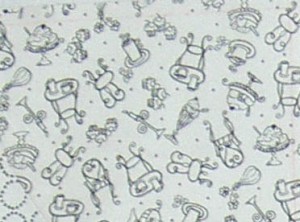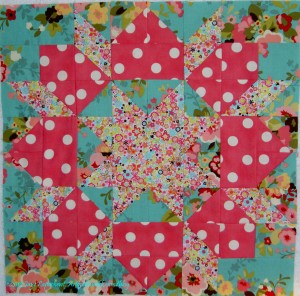Sandy and I spent some time talking about pattern the other day and here is the next installment of our Design series. You can listen to the accompanying podcast on Sandy’s site or via iTunes.
Pattern is an Element of Design
What we are talking about is NOT a “plastic baggy with the instructions for a quilt inside.” (A Fiber Artist’s Guide to Color & Design, pg.99)
Definition:
- “Pattern is a repetitive design with a motif appearing again and again.” (Quilter’s Book of Design, 2d, pg. 49)
- Pattern is “formed by the repeat of shape, line or form within a design field.” (A Fiber Artist’s Guide to Color & Design, pg.200)
- “…design or designs formed by the repeat of shape, line or form within the design field. When a shape is repeated three or more times a pattern is formed.” (A Fiber Artist’s Guide to Color & Design, pg.99)
The repetition of the motif, color, value, line, shape, or texture does not necessarily have to be identical in order to create a pattern. (Quilter’s Book of Design, 2d, pg. 49)
A pattern is often regular, high in contrast and represents something we can identify, like a plant. (Pentak & Lauer, pg. 168) See figure A
A quiltmaker can “use design elements such as solid colors and plain thread without any pattern in them, and use them in a way that creates a pattern in the whole composition.” (Quilter’s Book of Design, 2d, pg. 80)
“If fabric has a large scale pattern, its repetitions will not even be visible when small pieces are cut from it. If the fabric has a medium scale pattern, the repeats may be visible and be a strong part of the design.” “It is important to remember that the size of the fabric pattern will influence its readability at a distance.” (Quilter’s Book of Design, 2d, pg. 80)
Types of pattern: “patterns can be broadly grouped into categories according to their style or shape.” (Quilter’s Book of Design, 2d, pg. 81)
- geometric or amorphous: mostly straight lines with angles. Designs with curvilinear lines are sometimes geometric.
- Realistic: something can be identified such as objects or people (Quilter’s Book of Design, 2d, pg. 81) (The Tarts Come to Tea)
- abstract: simplified shapes that suggest a subject (Quilter’s Book of Design, 2d, pg. 81)
- non-objective: abstract without suggesting any realism(Quilter’s Book of Design, 2d, pg. 81)
Pattern used in Quiltmaking
- repeat motifs on a length of fabric, like dots. “Fabric will pattern may be used to contribute to the unity, balance, or variety in the design, but the scale of the pattern, that is its size in relationship to the size of the pieces that are cut will determine the impact of the pattern on the overall design of the quilt.” (Quilter’s Book of Design, 2d, pg. 80)
- repeat of a group of designs on a length of fabric (fabric repeat)
Notes:
- “A pattern is created when the viewer is led to anticipate the same elements in a design.” (Quilter’s Book of Design, 2d, pg. 49)
- “The repetition does not have to be symmetrical, nor does it have to be precisely place for the viewer to be able to anticipate or find a pattern. Sometimes a pattern is noticed by one viewer and not another.” (Quilter’s Book of Design, 2d, pg. 49)
-

Consistent Feel “The shape does does not have to the same size or scale [to create a pattern], but it does need to have a consistent feel.”(A Fiber Artist’s Guide to Color & Design, pg.99) The example of the fabric to the left has a variety of motifs, but the line quality and relation of motifs to each other gives the design a consistent feel. thus creating a pattern. Of course, there is a repeat in the design as well.
- “Pattern and texture are often used interchangeably because a pattern may give a surface the appearance of texture and because textures have a distinct repeating arrangement that creates a pattern.” (Quilter’s Book of Design, 2d, pg. 79)
- Pattern is sometimes called visual texture.
- “The essential distinction between texture and pattern seems to be whether the surface arouses our sense of touch or merely provides designs appealing to the eye. In other words, while every texture makes a sort of pattern, not every pattern could be considered a texture.” (Pentak & Lauer, pg. 168)
Examples:
- Claudine Helmuth points out Edouard Vuillard’s work. “He would fill his paintings to the brim with pattern. Every surface is covered in pattern, none of which normally go together but somehow it all works.” Claudine Helmuth’s Series on Finding your Artistic Style, pt.2)

The Swoon block shown was discussed in the episode as one of the examples.
Resources
A Fiber Artist’s Guide to Color & Design by Heather Thomas
Art+Quilt by Lyric Kinard
Claudine Helmuth’s Series on Finding your Artistic Style, pt.2: http://claudinehellmuth.blogspot.com/2012/04/finding-your-artistic-style-part-2.html
Design Basics by Pentak & Lauer
Homework Workshop.com (ochre image above)
Quilter’s Book of Design, 2d, by Ann Johnston
Textile Design blog –http://textiledesignss.com/textile-pattern-design/ (black & white image above)
This was a fabulous lesson Jaye! I have really enjoyed your design series episodes on Sandy’s podcast.
Thanks so much! That means a lot to me.